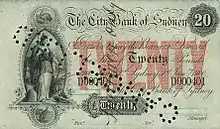| Bank Notes Tax Act 1910 | |
|---|---|
 | |
| Parliament of Australia | |
| |
| Citation | No. 14 of 1910 |
| Royal assent | 10 October 1910 |
| Repealed | 21 August 1945 |
| Repealed by | |
| Commonwealth Bank Act 1945 | |
| Status: Repealed | |
The Bank Notes Tax Act 1910 (Cth) was an Act of the Parliament of Australia which imposed a prohibitive tax on banknotes issued by banks in Australia.[1][2] The Act was enacted in October 1910 by the Fisher Labour Government under Section 51 (xii) of the Constitution of Australia that gives the Commonwealth Parliament the power to legislate with respect to “currency, coinage, and legal tender” and the taxing power.
The Act

The Act imposed an annual tax of 10% on "all bank notes issued or re-issued by any bank in the Commonwealth after the commencement of this Act and not redeemed."[2] The tax commenced in March 1911.[3]
In September 1910, the federal government had passed the Australian Notes Act 1910 which introduced an Australian national currency, the Australian pound, and, as part of the scheme, the objective of the Act was to end the use of private currency in Australia, which it had achieved.
Legacy
The Act was repealed by the Commonwealth Bank Act 1945,[4] enacted by the Chifley Labor government, which instead imposed a fine for issuing a private currency. S.44(1) of the Reserve Bank Act 1959 now prohibits private and state currencies.[5]
See also
References
- ↑ "Bank Notes Tax Act 1910". Commonwealth of Australia. Retrieved 14 November 2014.
- 1 2 "THE AUSTRALIAN NOTE ISSUE". Commonwealth of Australia. Retrieved 14 November 2014.
- ↑ Edmonds, Leigh (2010). "The 1910s: Laying the Foundations". A brief history of the Australian Taxation Office (PDF). Australian Taxation Office. pp. 5–22. Retrieved 30 April 2018.
- ↑ "Commonwealth Bank Act 1945". Commonwealth of Australia. Retrieved 26 November 2015.
- ↑ Reserve Bank Act 1959 (Cth), s.44